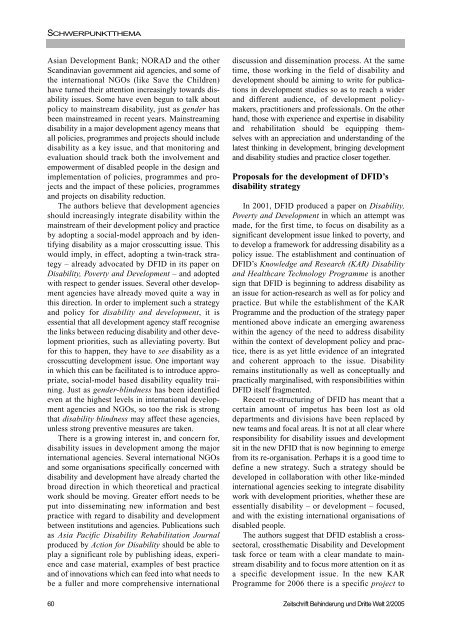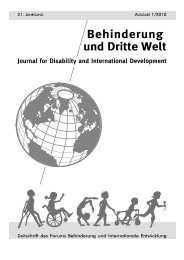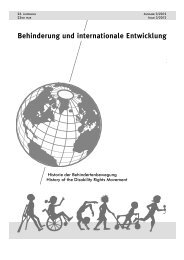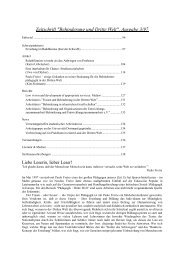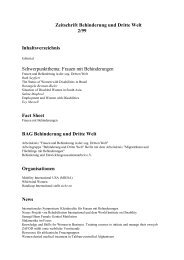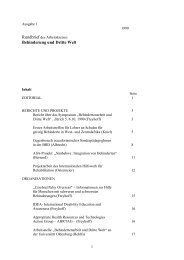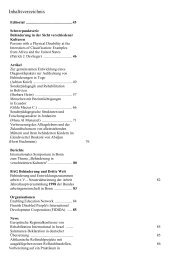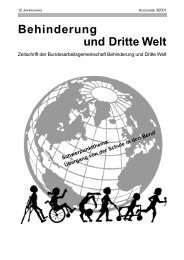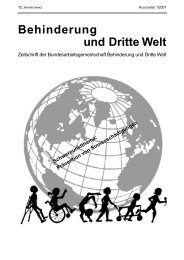Armut und Behinderung - Behinderung und Dritte Welt
Armut und Behinderung - Behinderung und Dritte Welt
Armut und Behinderung - Behinderung und Dritte Welt
You also want an ePaper? Increase the reach of your titles
YUMPU automatically turns print PDFs into web optimized ePapers that Google loves.
SCHWERPUNKTTHEMAAsian Development Bank; NORAD and the otherScandinavian government aid agencies, and some ofthe international NGOs (like Save the Children)have turned their attention increasingly towards disabilityissues. Some have even begun to talk aboutpolicy to mainstream disability, just as gender hasbeen mainstreamed in recent years. Mainstreamingdisability in a major development agency means thatall policies, programmes and projects should includedisability as a key issue, and that monitoring andevaluation should track both the involvement andempowerment of disabled people in the design andimplementation of policies, programmes and projectsand the impact of these policies, programmesand projects on disability reduction.The authors believe that development agenciesshould increasingly integrate disability within themainstream of their development policy and practiceby adopting a social-model approach and by identifyingdisability as a major crosscutting issue. Thiswould imply, in effect, adopting a twin-track strategy– already advocated by DFID in its paper onDisability, Poverty and Development – and adoptedwith respect to gender issues. Several other developmentagencies have already moved quite a way inthis direction. In order to implement such a strategyand policy for disability and development, it isessential that all development agency staff recognisethe links between reducing disability and other developmentpriorities, such as alleviating poverty. Butfor this to happen, they have to see disability as acrosscutting development issue. One important wayin which this can be facilitated is to introduce appropriate,social-model based disability equality training.Just as gender-blindness has been identifiedeven at the highest levels in international developmentagencies and NGOs, so too the risk is strongthat disability blindness may affect these agencies,unless strong preventive measures are taken.There is a growing interest in, and concern for,disability issues in development among the majorinternational agencies. Several international NGOsand some organisations specifically concerned withdisability and development have already charted thebroad direction in which theoretical and practicalwork should be moving. Greater effort needs to beput into disseminating new information and bestpractice with regard to disability and developmentbetween institutions and agencies. Publications suchas Asia Pacific Disability Rehabilitation Journalproduced by Action for Disability should be able toplay a significant role by publishing ideas, experienceand case material, examples of best practiceand of innovations which can feed into what needs tobe a fuller and more comprehensive international60discussion and dissemination process. At the sametime, those working in the field of disability anddevelopment should be aiming to write for publicationsin development studies so as to reach a widerand different audience, of development policymakers,practitioners and professionals. On the otherhand, those with experience and expertise in disabilityand rehabilitation should be equipping themselveswith an appreciation and <strong>und</strong>erstanding of thelatest thinking in development, bringing developmentand disability studies and practice closer together.Proposals for the development of DFID’sdisability strategyIn 2001, DFID produced a paper on Disability,Poverty and Development in which an attempt wasmade, for the first time, to focus on disability as asignificant development issue linked to poverty, andto develop a framework for addressing disability as apolicy issue. The establishment and continuation ofDFID’s Knowledge and Research (KAR) Disabilityand Healthcare Technology Programme is anothersign that DFID is beginning to address disability asan issue for action-research as well as for policy andpractice. But while the establishment of the KARProgramme and the production of the strategy papermentioned above indicate an emerging awarenesswithin the agency of the need to address disabilitywithin the context of development policy and practice,there is as yet little evidence of an integratedand coherent approach to the issue. Disabilityremains institutionally as well as conceptually andpractically marginalised, with responsibilities withinDFID itself fragmented.Recent re-structuring of DFID has meant that acertain amount of impetus has been lost as olddepartments and divisions have been replaced bynew teams and focal areas. It is not at all clear whereresponsibility for disability issues and developmentsit in the new DFID that is now beginning to emergefrom its re-organisation. Perhaps it is a good time todefine a new strategy. Such a strategy should bedeveloped in collaboration with other like-mindedinternational agencies seeking to integrate disabilitywork with development priorities, whether these areessentially disability – or development – focused,and with the existing international organisations ofdisabled people.The authors suggest that DFID establish a crosssectoral,crossthematic Disability and Developmenttask force or team with a clear mandate to mainstreamdisability and to focus more attention on it asa specific development issue. In the new KARProgramme for 2006 there is a specific project toZeitschrift <strong>Behinderung</strong> <strong>und</strong> <strong>Dritte</strong> <strong>Welt</strong> 2/2005


